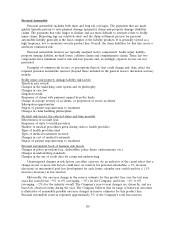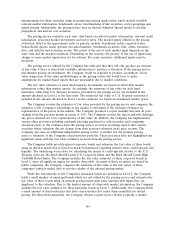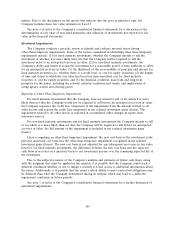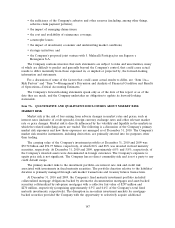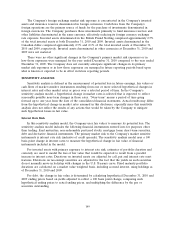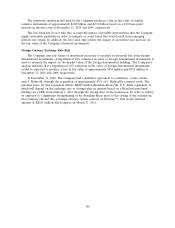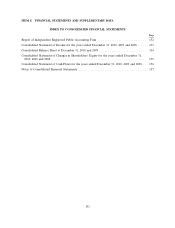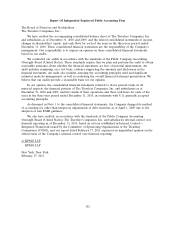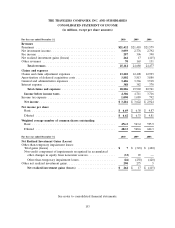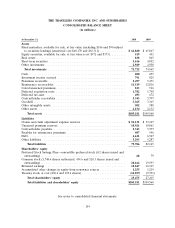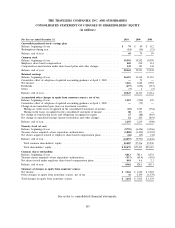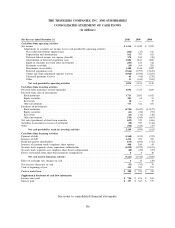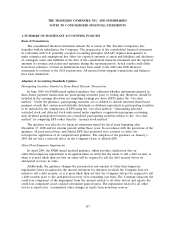Travelers 2010 Annual Report Download - page 160
Download and view the complete annual report
Please find page 160 of the 2010 Travelers annual report below. You can navigate through the pages in the report by either clicking on the pages listed below, or by using the keyword search tool below to find specific information within the annual report.asset-backed securities collateralized by sub-prime mortgages at discounted prices. The Company
purchased $31 million and $74 million of such securities in 2010 and 2009, respectively. The Company
defines sub-prime mortgage-backed securities as investments in which the underlying loans primarily
exhibit one or more of the following characteristics: low FICO scores, above-prime interest rates, high
loan-to-value ratios or high debt-to-income ratios. Alternative documentation securitizations are those
in which the underlying loans primarily meet the government-sponsored entities’ requirements for
credit score but do not meet the government-sponsored entities’ guidelines for documentation, property
type, debt and loan-to-value ratios. The average credit rating on these securities and obligations held by
the Company was ‘‘Baa2’’ and ‘‘A3’’ at December 31, 2010 and 2009, respectively.
The Company’s fixed maturity investment portfolio at December 31, 2010 included securities issued
by numerous states, municipalities and political subdivisions (collectively referred to as the municipal
bond portfolio), a number of which were enhanced by third-party insurance for the payment of
principal and interest in the event of an issuer default. The downgrade of credit ratings of insurers of
these securities in recent years has resulted in a corresponding downgrade in the ratings of the
securities to the underlying rating of the respective security. Of the insured municipal securities in the
Company’s investment portfolio at December 31, 2010, approximately 99% were rated at A3 or above,
and approximately 90% were rated at Aa3 or above, without the benefit of insurance. The Company
believes that a loss of the benefit of insurance would not result in a material adverse impact on the
Company’s results of operations, financial position or liquidity, due to the underlying credit strength of
the issuers of the securities, as well as the Company’s ability and intent to hold the securities. The
average credit rating of the underlying issuers of these securities was ‘‘Aa2’’ at December 31, 2010. The
average credit rating of the entire municipal bond portfolio was ‘‘Aa1’’ at December 31, 2010 with and
without the third-party insurance.
On April 2, 2009, municipal securities issued by local governments within the United States were
assigned a negative outlook by Moody’s Investors Service. Notwithstanding the relatively low historical
rates of default on many of these obligations and notwithstanding that the Company typically seeks to
invest in high-credit-quality securities (including those with structural protections such as being secured
by dedicated or pledged sources of revenue), during or following an economic downturn, the
Company’s municipal bond portfolio could be subject to a higher risk of default or impairment due to
declining municipal tax bases and revenue. The severity and duration of state and local government
budget deficits could have an adverse impact on the collectability and valuation of the Company’s
municipal bond portfolio. In addition, some issuers may be unwilling to increase tax rates, or to reduce
spending, to fund interest or principal payments on their municipal bonds, or may be unable to access
the municipal bond market to fund such payments. The risk of widespread defaults may increase if
some issuers voluntarily choose to default, instead of implementing difficult fiscal measures, and the
actual or perceived consequences (such as reduced access to capital markets) are less severe than
expected. The risk may also increase if there are changes in legislation that permit states, or additional
municipalities and political subdivisions, to file for bankruptcy protection or if there are judicial
interpretations that, in a bankruptcy or other proceeding, lessen the value of structural protections.
The Company’s tax-exempt fixed maturity investment portfolio totaled $39.03 billion and
$40.84 billion at December 31, 2010 and 2009, respectively. Federal and/or state tax legislation could be
enacted that would lessen or improve some or all of the tax advantages currently benefiting the
Company and result in an adverse or favorable impact on the value of these holdings.
The primary market risk for all of the Company’s debt is interest rate risk at the time of
refinancing. The Company monitors the interest rate environment and evaluates refinancing
opportunities as maturity dates approach. For additional information regarding the Company’s debt see
note 8 of notes to the Company’s consolidated financial statements as well as the ‘‘Liquidity and
Capital Resources’’ section of ‘‘Item 7—Management’s Discussion and Analysis of Financial Condition
and Results of Operations.’’
148


